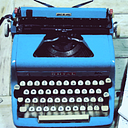
If You Want to Be an Artist, You Are: Steve Leadbeater
“I don’t consider a work finished until someone else has seen it.”
Featured work: Earthbound

Artist and designer Steve Leadbeater’s works are instinctual and sensitive; balanced and visceral; intuitive and haunting. His paintings and drawings are hewn in raw, saturated and, at times, dripping marks — some are grounded in universal archetypes, and some introduce fresh, imaginative characters. Others contain raw, scrawling messages from the artist — notes on creation, society and more.
“I always want it to be a reminder of the immense power, vulnerability and mystery of being human,” this Australia-based artist has said of his work. He recognizes the influence of Indigenous cultures on his aesthetic, and says his other inspirations range from Basquiat to Haring to Bowie. Scroll on to explore more of his rich imagery and his thoughts on his artmaking.
More featured works:









5 Questions for the Artist:
1. What is art to you?
A chance to explore. A chance to experience.
A chance to escape.
Art can bridge the gap between cultures and possibilities. If it was easy to explain, art would have died long ago.
2. What did you make in the past, and why?
When I was a kid, I drew reptiles, dinosaurs and monsters because they fascinated me and made my imagination soar.
As a teenager, I moved into street photography and abstract painting to reflect how I felt about what was happening around me in the suburbs. Industrial decline and commercial development were ugly sources of inspiration.
Then, I studied graphic design and communicated, often on behalf of clients, through graphics, imagery, color, composition, typography and the written word.
3. What are you making now, and why?
I draw and paint with a brutal naivety to expose a raw, emotional side of being human in a complex world that demands perfection. Often my work includes words, symbols and references to ancient cultures and everyday life, creating a sort of collage of energetic influence. The results can be mysterious, beautiful, confronting, funny or an unexpected mix. The process of creating art is like therapy to me and sharing the work is an important part of my practice. I don’t consider a work finished until someone else has seen it. I don’t need to know who saw it or what they think of it, just that it’s been seen.
4. What are your hopes for the future?
I would like to reach more people at a deeper level with my art.
5. What else would you like to say?
If you want to be an artist , you are. Fuck the traditional career path.
[These] are some of my biggest influences: David Bowie, Andy Warhol, Robert Rauschenberg, Pablo Picasso, Francis Bacon, Franz Kline, Keith Haring, Cy Twombly, Jean Michel Basquiat, Barbara Kruger, David Shrigley, Wasted Rita, A. R. Penck, Jesper Waldersten, Sergei Sviatchenko, Paul Davis, Rennie Ellis, Saul Leiter, John Olsen, Tony Tuckson, Barbara Kruger, Raymond Pettibon, James Victore, Robert Del Naja, Rosalie Gascoigne, Jenny Holzer, Iain McCaig, Alexander Calder, Jackson Pollock, Egon Schiele, Indigenous cultures from around the world, Brian Roettinger, Dennis Hopper, William S. Burroughs, Patti Smith, Austin Kleon, Simon Sinek, Steven Pressfield, Steven Heller, Bad Brains, The Clash, Mess Hall, Black Rebel Motorcycle Club, The Pixies, LCD Soundsystem, and Fugazi.
Artist Supplied Bio:

Steve Leadbeater acknowledges the Traditional Owners of the lands in which he lives and works. He pays respect to Elders past, present and emerging. He’s exhibited his work since the early ’90s, but he’s been drawing his whole life. Decades as a graphic designer have given him a deep understanding of visual communication.
Leadbeater’s work is driven by contrasts — identity and anonymity, sensitivity and brutality, spirit and form. Although these themes are universal, it’s often difficult to divorce the art from its suburban context.
Expressive mark making gives his subjects a kind of wild emotive energy. That could be why the work polarizes audiences, they either love it or fear it. He can’t control their reaction, but he’s glad they’re moved. The work reflects the immense power, vulnerability and mystery of being human — while retaining a playful naivety. He’s grateful to both the supporters and opposers of his work. Without them, his practice wouldn’t be the cathartic experience he continually craves.
Find more of Steve Leadbeater’s work on Instagram.
Learn more about the Ask Artists interview series and submissions, which features all forms of creative expression.
